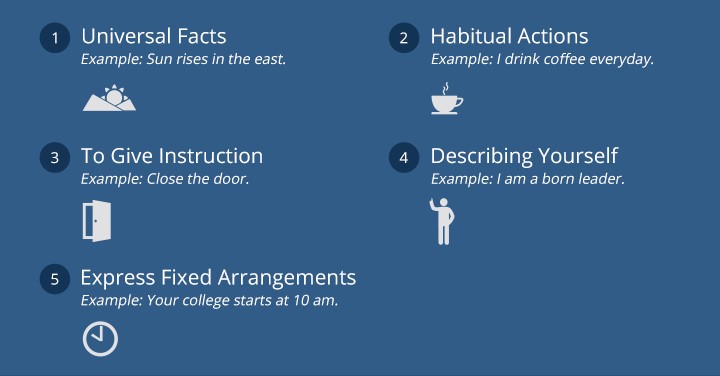Simple Present Tense is one of the 4 sub-tenses of Present Tense. Simple Present tense refers to those actions which are regular and general in nature. It deals with repeated actions or constant situations. It can be understood more clearly with the study of its structures.

The structures of the Simple Present Tense with examples are as follows:
1. Sub + v1/v5 + obj. (Affirmative i.e. Positive sentence)
For Example:
- She plays chess.
- They clean their rooms.
2. Sub + does not/doesn’t + v1 + obj. (Negative sentence)
For Example:
- She does not play chess.
- They do not clean their room.
3. Do/Does + sub + v1 + obj? (Positive Interrogative)
For Example:
- Does she play chess?
- Do they clean their room?
4. Do/Does + sub + not + v1 + obj? (Negative Interrogative)
For Example:
- Does she not play chess?
- Don’t they clean their room?
5. Wh-word + do/does + sub + v1 + obj? (Wh-Question)
For Example:
- What does she eat?
- What do they clean?
Where Simple Present Tense is used?

Simple Present Tense is used with actions which are regular and repetitive in nature. Mostly, the habits of people are expressed with the help of Simple Present Tense.
- I always sleep late.
- My best friend scolds me every day.
- He often wakes up in middle of the night and cries remembering her.
- She often spends money recklessly.
- We often eat our lunch at home.
Simple Present Tense is used with truth, universal facts and scientific principles.
- The sun rises in the east.
- Tiger is a carnivorous animal.
- Mammals are warm bodied animals.
- Our blood is always red regardless the color of our skin.
- The dog has only four teeth left.
Simple Present Tense is used with general truths i.e. actions/events which most of the time turn out to be
- It is cold and dry in winter.
- The President of The United States lives in the White House.
- Dalai Lama preaches about Buddhism.
- Spring is one of the most beautiful seasons.
- The poor people of developing countries suffer more due to inflation.
Simple Present Tense is used with Proverbs and axioms.
- A rising tide lifts all boats.
- Slow and steady wins the race.
- Action speaks louder than words.
- Honesty is the best policy
- A new broom sweeps clean.
Simple Present Tense is used with definite future actions/events.
- My work gets over tomorrow.
- Students go to tour tomorrow.
- The school closes at 4 in the evening.
- The prime minister of Australia arrives to Italy nest week.
- My sister graduates in August this year.
Simple Present Tense is used with sentences which express instructions, requests and commands i.e. Imperative sentences.
- Sit down.
- Please, help me.
- Improve your handwriting.
- Don’t litter the park area.
- Labor hard to achieve success.